WES Lexmark - Create and configure the WES profile
Create the WES profile
On a clean Watchdoc installation, a first WES profile is automatically created with default parameters at the end of the wizard procedure, but you can, at any time, edit existing profiles to modify them or create a new profile.
-
From the Main menu in the administration interface;
-
in the Configuration section, click on Web, WES & Scan destinations:
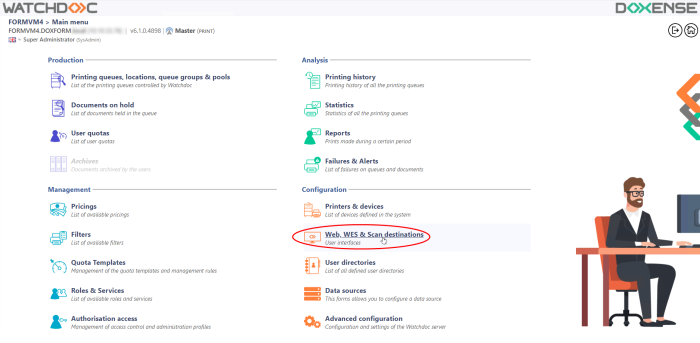
-
in the Web, WES & Scan Destinations - Client Interface Management interface, click on Create a new WES profile;
-
in the list, select the profile you want to create:
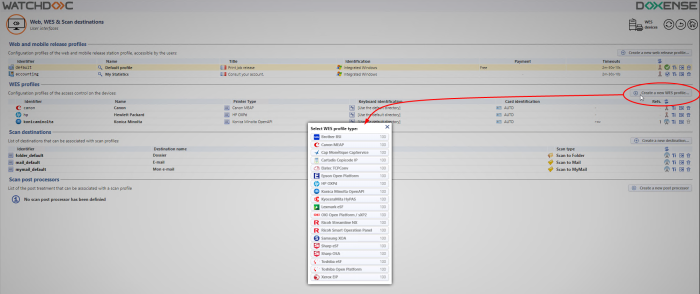
è you will access the Create a WES profile form, which contains a number of sections in which you can configure your WES.
A navigation bar helps you quickly access the desired section:
Configure the Lexmark WES profile
Properties section
Use this section to state the main WES properties:
-
Identifier: Enter the single identifier for the WES profile. It can comprise letters, numbers and the '_' character with a maximum of 64 characters. This identifier is only displayed in the administration interfaces.
-
Name: Enter the WES profile name. This explicit name is only displayed in the administration interfaces.
-
Global: In the case of a domain configuration (master/slaves), tick this box to replicate this profile on the slave servers.
-
Language: Select the WES display language configured from the list. If you select Automatic detection, the WES adopts the language it finds by default in the device configuration.
-
Version: Select the version of WES. For v3, you can customise the interface by choosing the colour of the buttons and images to match your graphic identity see Customize the WES:
-
Colour: enter the Hexadecimal color value corresponding to the WES button's colour. By default, the buttons are Watchdoc orange customized (#FF901). Once the value is entered, the colour is displayed in the field.
-
Images: if you want to customize the WES images, enter the folder path in which are recorded images you want to display instead of the default images (stored in C:\Program Files\Doxense\Watchdoc\Images\Embedded\Doxense\[Manufacturer_Name] by default).
-
Keyboard authentication mode section
-
Keyboard authentication: tick the box (at the section level) to enable user authentication from a physical keyboard or the touch screen one, then set out how this authentication works:
Allow PUK
(Print User Key). In Watchdoc, this is a code (associated with a user account but used alone) sufficient to allow the user to authenticate in a WES. The PUK code is generated thanks to an algorithm. The user can consult it in the "My account" page of Watchdoc. For security reasons, we advise against using the PUK code and recommend using a login (user account)/PIN code. Code authentication: the PUK code is automatically generated by Watchdoc according to the parameters defined in the directory and communicated to the user on the "My account" page.
Allow Login and PIN Code authentication: consisting of 4 or 5 digits, the user PIN code (1234, for example) is registered as anLDAP attribute or in a CSV file. It is associated to the user login (available with the Watchdoc 5.1 version).
Login and password authentication: users will use their LDAP credentials. We do not recommend using this mode.
-
Directory: From the list, select the directory to query during keyboard authentication. If no directory is set, Watchdoc will query the default directory.

Card authentication section
Card authentication: tick the box (at the section level) to enable user authentication from a card, then set out how this authentication works:
-
Directory: From the list, select the directory to query during cards authentication. If no directory is set, Watchdoc will query the default directory.
-
Self registration : If you enable the self-registration
 An action in which a user account is associated with its own card code. Registration is carried out the first time a card is used. The registration can be carried out by the IT manager when he issues the card to a user or by the user himself who enters his identifier (PIN code, PUK code or username and password) which is then associated with his card code. Once the registration is completed, the card code is permanently associated with its owner. from the WES, state how the user assigns their card to their account:
An action in which a user account is associated with its own card code. Registration is carried out the first time a card is used. The registration can be carried out by the IT manager when he issues the card to a user or by the user himself who enters his identifier (PIN code, PUK code or username and password) which is then associated with his card code. Once the registration is completed, the card code is permanently associated with its owner. from the WES, state how the user assigns their card to their account:-
with PUK code: the embedded solution will ask the user for its PUK code. If the PUK code is correct, Watchdoc stores the card number with the user's login in its database;
-
with login and PIN code: the embedded solution will ask the user for his login and his PIN cpde.
-
with login and password: the embedded solution will ask the user for his login and his password. If the data keyed in are correct, Watchdoc stores the card number with the user's login in its database.
-
Notify the user on self-registration: check this box to send a notification to the user when his badge has been enrolled.
-
-
Format : State, where necessary, how the character string for the badge number string is to be transformed. E.g. raw;cut(0,8);swap.
-
Display timeout:Specify the time, in seconds, during which the auto-enrolment interface is displayed before returning to the authentication page.

Anonymous section
Tick this section to activate the Anonymous connection in order to allow an unauthenticated user to access to the device by clicking a button.
It is possible to restrict the features that the anonymous user can access by applying a privilege policy to the queue, group, or server, and using the Anonymous User filter.
-
Button Label: Enter in this field the label displayed on the access button to the device features. By default, the text is Anonymous;
-
Redirection: From the list, choose the application to which the anonymous user must access after clicking the Anonymous:
-
Home: The user accesses to the device homepage;
-
Copy Application: The user accesses to the copy application;
-
Scan Application: The user accesses to the scan feature;
-
Fax application: The user accesses to the scan feature;

-
Accounting section
In this section, specify whether you want the accounting to be performed by the device itself or from the Watchdoc parser.
- Device > Uses the prints accounting information from the device : tick this box if you want accounting to be supported by the device instead of the Watchdoc parser. This only applies to print jobs. Results are more reliable especially when the job is not fully printed (canceled).

Pull-print section
In this section, you can change options about the Watchdoc release application: sort order of the document, tariff information and optional pages.
You can bypass this application by enabling the automatic release mode. When the user is authenticated on the device, all its documents are released.
-
Inactivity time out:
-
Sort Order: Set the documents order on the device screen:
-
Reverse chronological: More recent documents will top the list ;
-
Chronological: Older documents will top the list.
-
-
Redirection: if the user has no print jobs waiting, specify the behaviour of the WES:
-
Smart: the WES displays the default home interface;
-
Home: the WES goes directly to the home page;
-
Waiting jobs: the WES displays the list of pending documents even if there are none.
-
Copy application: the device's copy interface is displayed;
-
-
Release all documents at login: When the user logs on, Watchdoc releases all user documents on the device where he logs on. In this case, the user cannot access the list of pending jobs to delete or print them.
-
All documents are checked by default: tick the box to ensure that all pending jobs are automatically ticked in the list of pending jobs when the user authenticates.
-
Optional pages: Tick the box o enable user adding more pages previews:
-
Enable Page Zoom: User can have a page by page preview (PCL 6 driver required)
-
Enable spool edition: User carn modify the initial printing criteria;
-
-
Display Options: from the list, select the pricing information displayed to the user via the WES: none, the price or the cost of their printouts.
-
Force the monetary display to 2 decimal digits: Tick the box to limit the number of decimal digits displayed to the user in the tariff information.
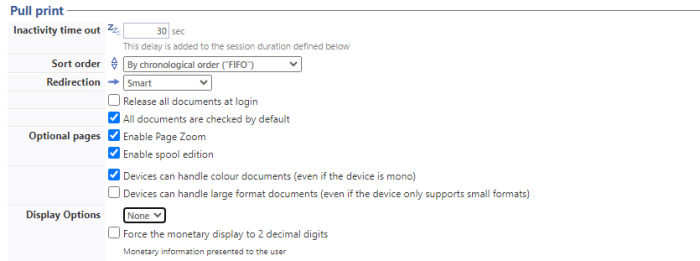
-
Scan section
This section is used to configure the WEScan function. It can only be activated with a WES V3.
-
Display settings - Use the last values chosen by users: allows the user to be offered the most used scanning profiles (predefined settings), which offers a time saving when scanning uses are often the same. Then specify whether the classification should be done using:
-
the type of profile: (the most frequently chosen profile);
-
the date of use (profile chosen the last time it was used).
-
-
Open default profile bar: provides an interface in which the user can choose between all the scanning parameters, which is useful when the scanning uses are very varied. Then specify whether you want to display the settings or the (pre-set) profiles.
-
the scan settings ;
-
the scan profiles (pre-configured).
-
-
Allow users to switch display modes: tick this box to allow the user to customize their interface by choosing their preferred display mode.
-
Scan profiles: for each profile listed, you can check:
-
activation: to make it active in the embedded interface;
-
inheritance: to allow the user to create a new profile inheriting the parameters of the existing profile. The user will then be free to modify one or more parameters of the original profile;
-
Post processing: if a post-scan treatment has been configured (see Post-scan processor), select it from the list ;
-
destinations : the destination is the place where the scanned document is sent. For each profile, you can activate, deactivate and define one or more destinations by default:
-
E-mail: Send the scan to the e-mail of a recipient entered in the interface;
-
My e-mail: send the scan to the user's email (always known if the user has an AD account);
-
Folder: send the scan to a predefined folder in the workspace accessible to the user.
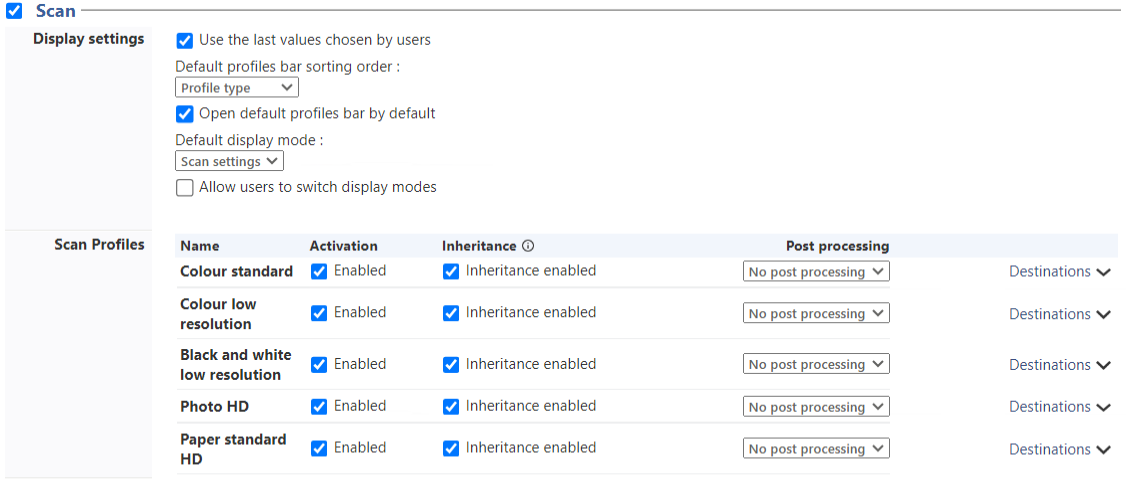
-
-
Device section
This section is used to define the connection mode between the server and the print devices.
-
Session Timeout: Lexmark devices natively manage the automatic closing of the user session after a time configured in its options. To facilitate configuration, it is possible to specify this time in the form. The duration is taken into account when the embedded application is installed or when its configuration is updated.
-
Server Address type: The device needs to contact the Watchdoc server when the user tries to connect or wants to release his documents. You can specify the Watchdoc server address in three different ways: IP Address, DNS Address and Custom Address ;
-
Connection mode: Enables you to enable or disable SSL for the communications between the MFP and the server:
-
Mixed: the application uses SSL for sensitive data (PUK code, login/mdp, etc.) and not SSL for non-sensitive data;
-
SSL Only: select this item if the WES must use SSL to communicate with the server.
-
No SSL: Select this item if the WES does not ever use SSL to communicate with the server.
-
-
Secure endpoint: if you have selected an SSL or Mixed connection mode, since v. 6.1.0.5262 you can specify whether you wish to use:
-
the custom access point (previously configured in the DSP section (see Configuring the Web Server):
-
the Watchdoc server's default port 5753 ;
-
- Device security: enter the administrator login and password required to access the device.
TLS/SSL: tick the following box if you want to secure the device access.

Failover options section
In this section, you configure the behaviour of the print devices in the event that the Watchdoc server does not respond.
-
Ping interval: specify, in seconds, the frequency with which the device polls the server to check its configuration and inform it that it is operating correctly;
-
Number of attempts: specify the number of connections the device should attempt to the main server before switching to the standby server.
-
Offline mode: activate or deactivate offline mode
 Mode enabling the print device to operate in a degraded manner in the event of the print servers (main and backup) failing. In offline mode, printing is impossible, but the device's other functions can be offered: photocopying, faxing and scanning.
If offline mode is disabled, in the event of a server failure, all device functions are blocked until the server is repaired.
This mode is configured in the WES profile applied to the device. and complete the list by indicating the authorised functions if the server is off:
Mode enabling the print device to operate in a degraded manner in the event of the print servers (main and backup) failing. In offline mode, printing is impossible, but the device's other functions can be offered: photocopying, faxing and scanning.
If offline mode is disabled, in the event of a server failure, all device functions are blocked until the server is repaired.
This mode is configured in the WES profile applied to the device. and complete the list by indicating the authorised functions if the server is off: -
Copy access: Tick this box to enable the user to copy;
-
Scan access: Tick this box to enable the user to scan;
-
Colour access: Tick this box to enable the user to print in color;
-
Fax access: Tick this box to enable the user to send documents by fax;
-
Print access: Tick this box to enable the user to print documents.
-
-
Multiserver options - Enable multiserver management: tick this box to relay requests to a backup server in the event of failure of the server with which the WES is associated, then enter the information required to access it in the Server list (in priority order): backup server address; https port; http port.
Then check the functions provided by the backup server options:-
Disable user authentication: tick this box if the rescue server does not authenticate users. For each request, it returns the details of an anonymous user with the rights defined for an anonymous user on the main server. The work carried out is then recorded under the "anonymous" account;
-
Disable accounting: If this is checked the accounting elements will be held on the device until it reconnects to the primary server. This is useful if you wish the accounting to be all sent to the same sever (if the databases are not common for example)
-
Disable pull print: With this option, the print on demand application will be disabled. This is useful because if the backup server has no access to the jobs of the user.
-
Disable self-registration: With this option, the self-registration will not be available on the backup server. This is useful if the cards database are not the same for both servers.
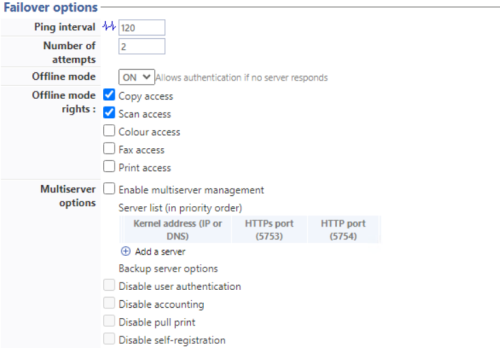
-
Miscellaneous section
In this section, you configure the behaviour of print devices in the event that the Watchdoc server does not respond.
-
Log Options - Destination: specify where the application should collect the information it records in the log files:
-
file: tick this box to save the information in a file accessible by Watchdoc;
-
device: tick this box to save the information on the device;
-
all: tick this box to save the information in a file accessible by Watchdoc and on the device.
-
Log options - Level: specify the level of detail of the WES information recorded:
-
profile: select this option to keep the traces left in the event of the WES profile ;
-
debug: select this option to keep the traces left in the event of a WES malfunction;
-
verbose: select this option to keep all traces of the WES;
-
info: select this option to keep only a minimum of information about how wes works;
-
warning: select this to keep all traces left by the WES in the event of an alert;
-
error: select this to keep a record of any error detected by the WES;
-
fatal: select this to keep a record of all blocking WES malfunctions.
-
-
-
CA Certificate: Enter the path to the certificate (signed by a Certificate Authority) specifically for Lexmark printing devices, or leave blank if the certificate is self-signed;
-
Custom applications: tick this box if you wish to install specific applications on the WES, then specify their name and the path to the application file (specific badge reader driver, for example).
-
Use an OEM code: tick the box and enter the OEM code used for the Lexmark device in the field.

Custom rights section
In this section, tick the boxes corresponding to the rights to be granted to users connected to the WES :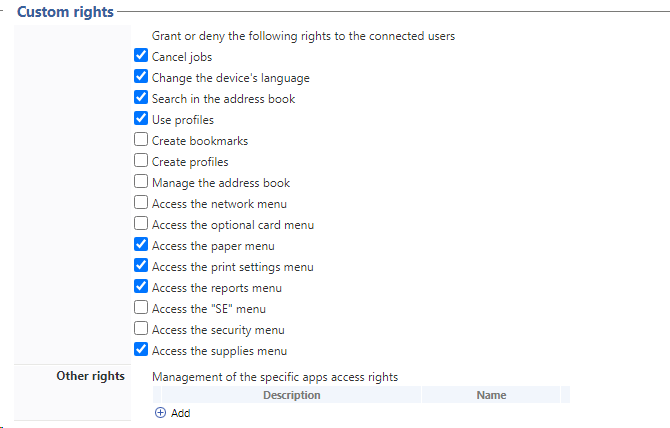
Validate the profile
1. Click on the  button to validate the WES profile configuration.
button to validate the WES profile configuration.
→ Once validated, the WES profile can be applied to a print queue.